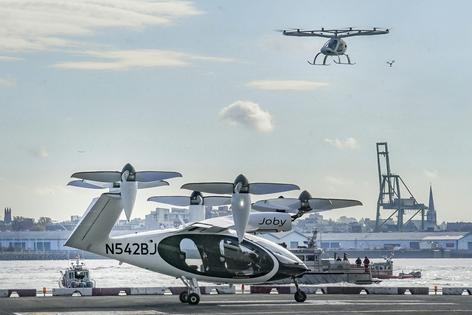Electric air taxis are on the way – quiet eVTOLs may be flying passengers as early as 2025
Published in Science & Technology News
Imagine a future with nearly silent air taxis flying above traffic jams and navigating between skyscrapers and suburban droneports. Transportation arrives at the touch of your smartphone and with minimal environmental impact.
This isn’t just science fiction. United Airlines has plans for these futuristic electric air taxis in Chicago and New York. The U.S. military is already experimenting with them. And one company has a contract to launch an air taxi service in Dubai as early as 2025. Another company hopes to defy expectations and fly participants at the 2024 Paris Olympics.
Backed by billions of dollars in venture capital and established aerospace giants that include Boeing and Airbus, startups across the world such as Joby, Archer, Wisk and Lilium are spearheading this technological revolution, developing electric vertical takeoff and landing (eVTOL) aircraft that could transform the way we travel.
Electric aviation promises to alleviate urban congestion, open up rural areas to emergency deliveries, slash carbon emissions and offer a quieter, more accessible form of short-distance air travel.
But the quest to make these electric aircraft ubiquitous across the globe instead of just playthings for the rich is far from a given. Following the industry as executive director of the Oklahoma Aerospace Institute for Research and Education provides a view of the state of the industry. Like all great promised paradigm shifts, numerous challenges loom – technical hurdles, regulatory mazes, the crucial battle for public acceptance and perhaps physics itself.
Fixed somewhere between George Jetson’s flying car and the gritty taxi from “The Fifth Element,” the allure of electric aviation extends beyond gee-whiz novelty. It is rooted in its potential to offer efficient, eco-friendly alternatives to ground transportation, particularly in congested cities or hard-to-reach rural regions.
While small electric planes are already flying in a few countries, eVTOLs are designed for shorter hops – the kind a helicopter might make today, only more cheaply and with less impact on the environment. The eVTOL maker Joby purchased Uber Air to someday pair the company’s air taxis with Uber’s ride-hailing technology.
In the near term, once eVTOLs are certified to fly as commercial operations, they are likely to serve specific, high-demand routes that bypass road traffic. An example is United Airlines’ plan to test Archer’s eVTOLs on short hops from Chicago to O'Hare International Airport and Manhattan to Newark Liberty International Airport.
While some applications initially might be restricted to military or emergency use, the goal of the industry is widespread civil adoption, marking a significant step toward a future of cleaner urban mobility.
One of the most significant technical challenges facing electric air taxis is the limitations of current battery technology.
...continued








Comments